Top Invoice Automation Software of 2025 | Save Time & Boost Efficiency
Discover the best invoice automation software of 2025. Explore features, pricing, and real-use cases to streamline your invoicing process today!
Tags
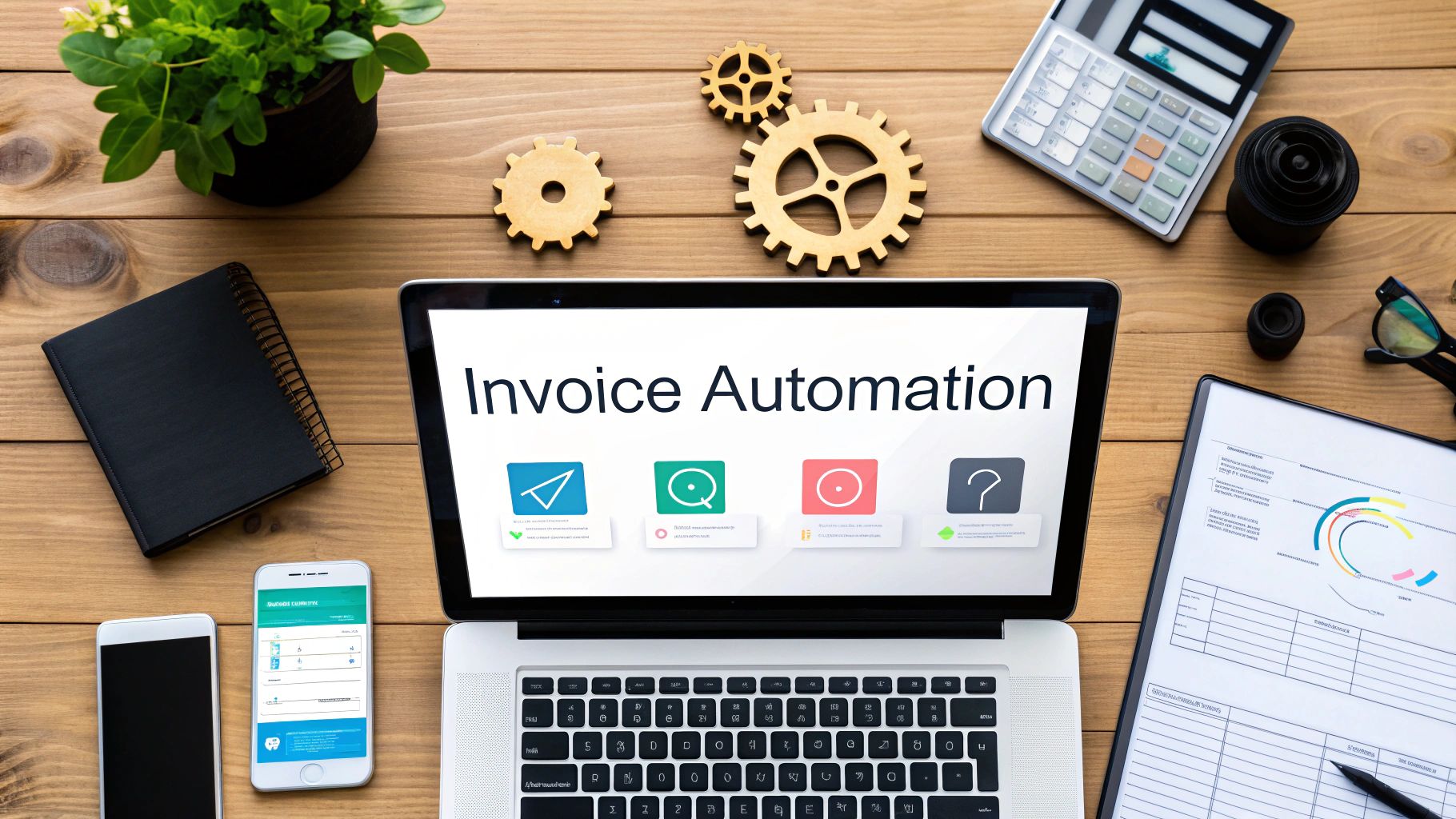
Escape the Paperwork Pile-Up: Your 2025 Guide to Smarter Invoicing
If you're spending hours each week chasing, entering, and organizing invoices, you know the drill. It's a time-consuming, error-prone process that pulls you away from growing your business. From deciphering blurry PDFs to manually keying data into spreadsheets, the friction of traditional invoice management leads to late payments, missed early payment discounts, and a constant, low-level administrative headache.
But what if you could reclaim that time and eliminate those errors for good? That's the promise of invoice automation software. These powerful platforms use AI and smart integrations to capture, read, and process your invoices automatically, transforming your financial workflow from a chore into a strategic advantage. For businesses with mobile teams, integrating billing with on-site work is a game-changer. To further streamline these processes, you can learn more about field service automation to connect your operations directly to your finance tools.
In this in-depth guide, we'll cut through the marketing noise and compare the 12 best invoice automation solutions for 2025. We'll dive deep into their standout features, practical use cases, real-world limitations, and pricing structures, so you can confidently choose the right tool to put your invoicing on autopilot.
1. GetInvoice
GetInvoice stands out as a premier invoice automation software engineered to eliminate manual data entry. It seamlessly connects with your email inboxes (Gmail, Outlook) and vendor portals, automatically capturing invoices in any format, from PDFs and images to email body text. Its advanced AI accurately extracts, classifies, and populates invoice fields, with the platform promising to process your first invoice in under 40 seconds.

Key Strengths & Use Cases
What truly sets GetInvoice apart is its deep integration with accounting systems like QuickBooks and Xero, alongside productivity tools such as Google Drive. This creates an uninterrupted data flow perfect for accountants managing multiple clients or fast-growing businesses. A standout feature is the AI-powered rules engine for custom tagging and exception handling, which is a core principle of modern Digitale Rechnungsverarbeitung. It even offers a reconciliation tool that matches invoices against bank statements, flagging missing documents to ensure financial accuracy.
Limitations
While powerful, the free plan is limited to 10 invoices per month, making it more of a trial for businesses with significant volume. Accessing higher processing limits and more advanced features requires upgrading to a paid subscription plan.
To see these features in action, you can explore their detailed guide on automating the invoice processing workflow.
2. FreshBooks
FreshBooks is a cloud-based accounting solution designed specifically for freelancers and small service-based businesses. While it's a full accounting suite, its strength lies in being a highly intuitive invoice automation software. It excels at streamlining the entire billing cycle, from tracking billable hours and expenses with receipt capture to creating and sending professional invoices in just a few clicks.

Key Strengths & Use Cases
The standout feature is its seamless integration of time tracking directly into invoicing, making it ideal for consultants, agencies, and tradespeople who bill by the hour. You can set up automated recurring invoices for retainers and send automatic payment reminders to reduce late payments. The platform also offers a dedicated client portal where customers can view, print, and pay their invoices online, creating a professional and transparent experience. Its excellent mobile app and multi-currency support are perfect for professionals on the go.
Limitations
FreshBooks is built for simplicity, which means its invoice customization options are more limited compared to some enterprise-level tools. While perfect for small teams, the per-user pricing on higher-tier plans can become costly as your business scales and requires more team members to have platform access.
You can explore how these features support small businesses on the FreshBooks website.
3. Zoho Invoice
Zoho Invoice establishes itself as a powerful and completely free invoice automation software, tailored specifically for freelancers and small businesses. It simplifies the entire billing cycle by offering customizable templates, automated payment reminders, and expense management in a single, user-friendly platform. The software is designed to get users up and running quickly, focusing on core invoicing needs without overwhelming complexity.
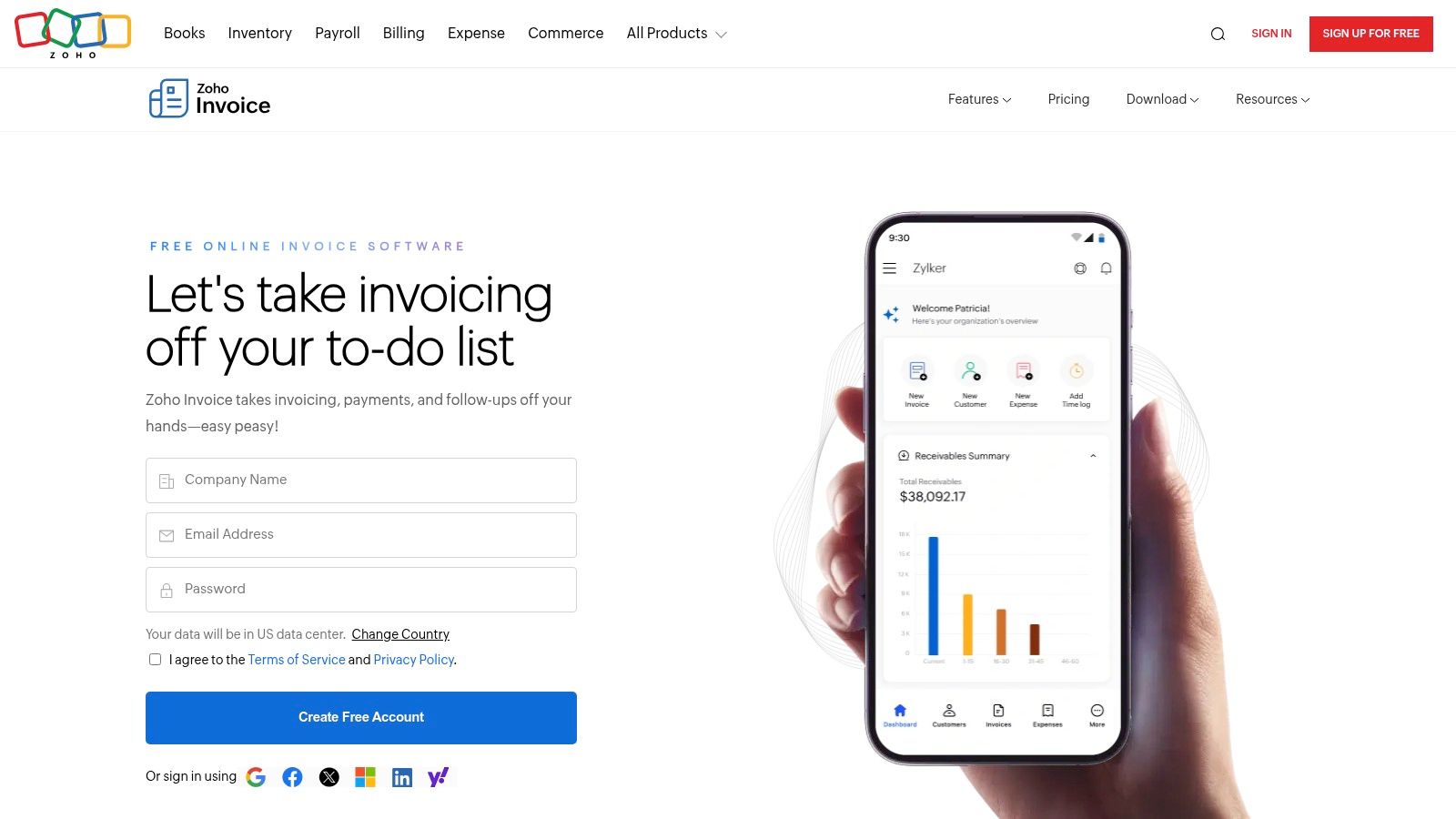
Key Strengths & Use Cases
The platform's greatest strength is its seamless integration within the broader Zoho ecosystem, creating a unified business management experience. It's ideal for consultants or small agencies that rely on project-based billing, thanks to its built-in time tracking and expense logging features. A key differentiator is the client portal, which allows customers to view invoices and make payments directly, improving transparency. Its multi-currency support also makes it a strong contender for freelancers with international clients.
Limitations
While its free offering is generous, Zoho Invoice's primary limitation is the cap of a single user and five customers per organization. This makes it unsuitable for businesses looking to scale their client base or those needing collaborative team access. Growing businesses will quickly outgrow these constraints and may need to explore other Zoho products or alternative platforms.
You can learn more about its robust free plan on the official Zoho Invoice website.
4. Xero
While primarily known as a comprehensive accounting platform, Xero provides powerful invoice automation software capabilities designed for small to medium-sized businesses. It streamlines the entire accounts receivable process, from creating branded, customizable invoices to sending automated payment reminders. The platform’s core strength lies in its real-time financial tracking and seamless integration with hundreds of payment gateways, making it a complete financial hub.
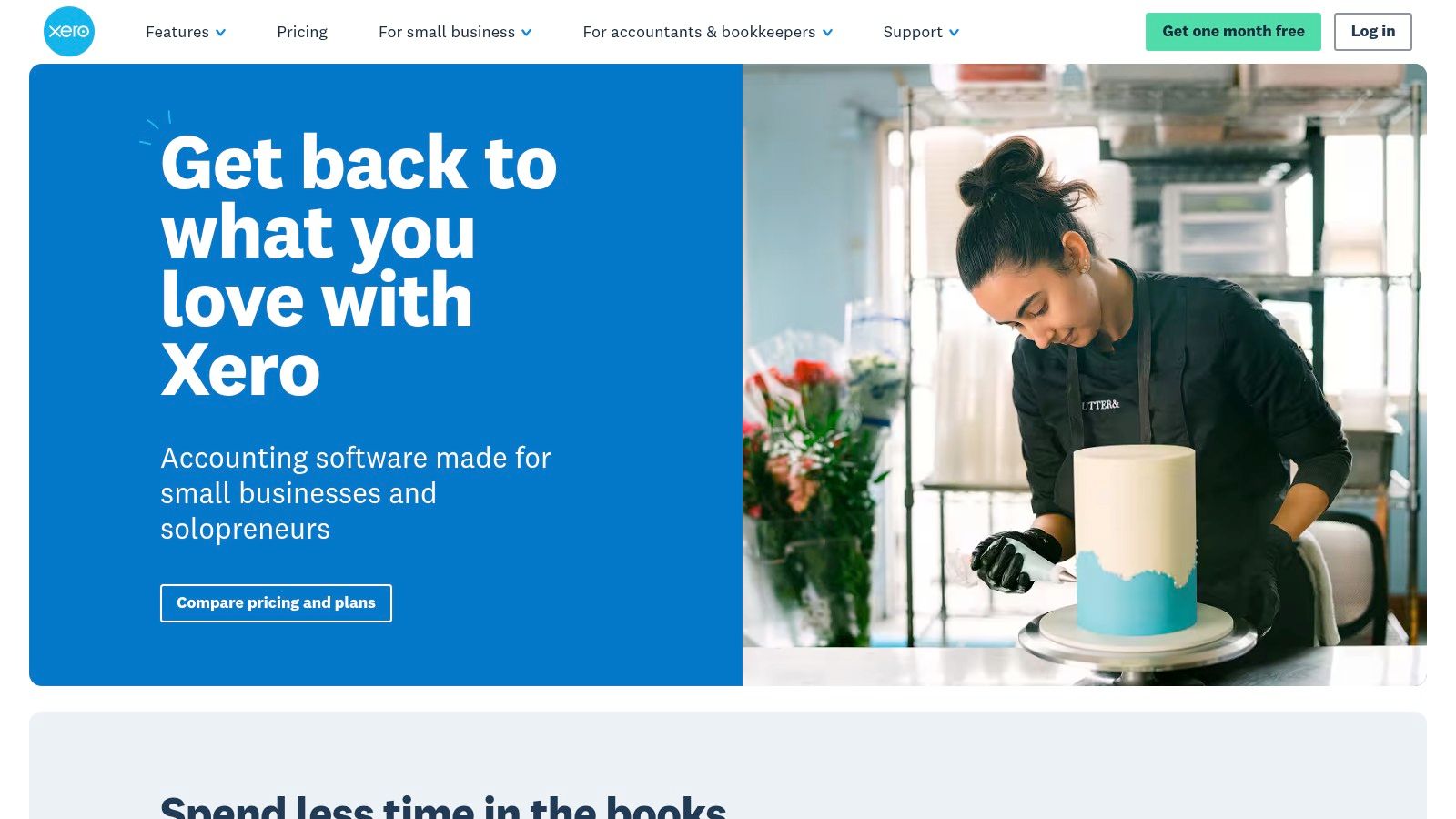
Key Strengths & Use Cases
Xero's intuitive interface makes it incredibly accessible, requiring minimal training for teams to get started. Its true power for on-the-go professionals lies in its robust mobile app, which allows users to create and send invoices directly from their phones. For businesses operating globally, the multi-currency support with automatic exchange rate updates is a game-changer, simplifying international transactions. The platform excels at automating recurring invoices and follow-ups, making it ideal for subscription-based services or freelancers with regular client retainers.
Limitations
Although Xero is very user-friendly, its reporting capabilities are more basic when compared to enterprise-level accounting systems, potentially lacking the deep analytics larger organizations require. Additionally, its customer support availability can be a challenge for users operating outside of its primary service regions' time zones. This makes it a better fit for SMBs that don't need 24/7 support or highly complex financial reporting.
You can explore its full suite of features and pricing plans on the Xero website.
5. QuickBooks Online
QuickBooks Online is a household name in accounting that doubles as a robust invoice automation software for small to medium-sized businesses. It goes beyond simple invoicing by integrating it into a complete financial ecosystem. Users can create professional invoices, track their real-time status, and accept payments directly, streamlining the entire accounts receivable process from one central dashboard.
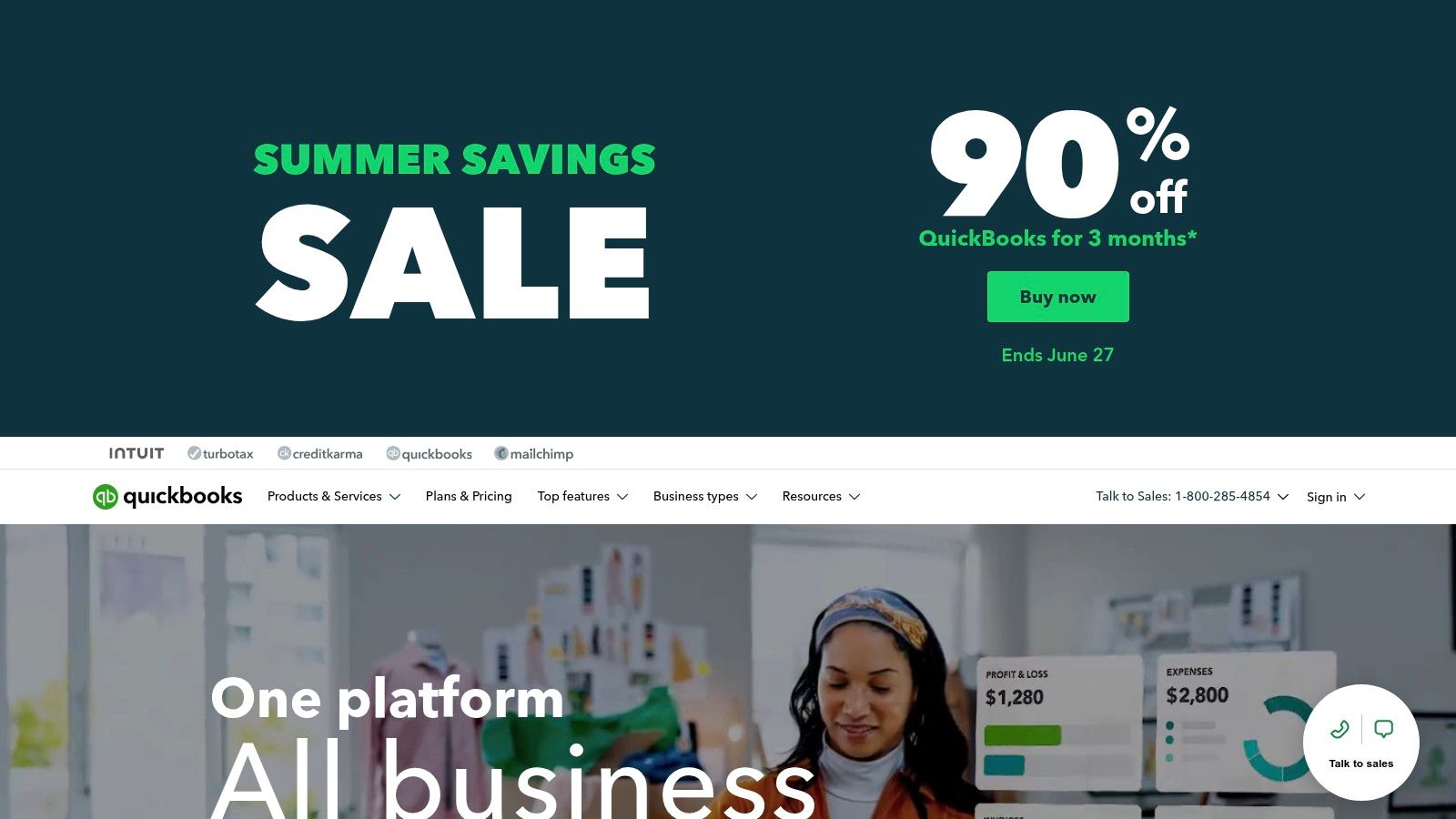
Key Strengths & Use Cases
QuickBooks' primary strength is its all-in-one nature, creating a single source of truth for all financial data. It is perfect for businesses managing everything from invoicing to payroll and tax preparation. Key automation features include scheduling recurring invoices for subscriptions and sending automatic payment reminders to reduce late payments. Its powerful mobile app allows users to create invoices and capture expense receipts on the go, making it a complete solution for effective invoice management for small businesses.
Limitations
While comprehensive, businesses needing only standalone invoicing may find the full accounting suite and associated pricing excessive. The invoice template customization is functional but offers less creative freedom compared to specialized invoicing platforms. Accessing more advanced features requires upgrading to higher-priced tiers, which can become a considerable expense for smaller operations.
6. Invoicera
Invoicera is a versatile online invoicing and billing platform positioned as a comprehensive invoice automation software for businesses of all sizes. It focuses on streamlining the entire accounts receivable workflow, from creating highly branded invoices to collecting payments. The platform supports automated recurring invoices and payment reminders, making it a strong choice for subscription-based services or businesses operating on retainers.
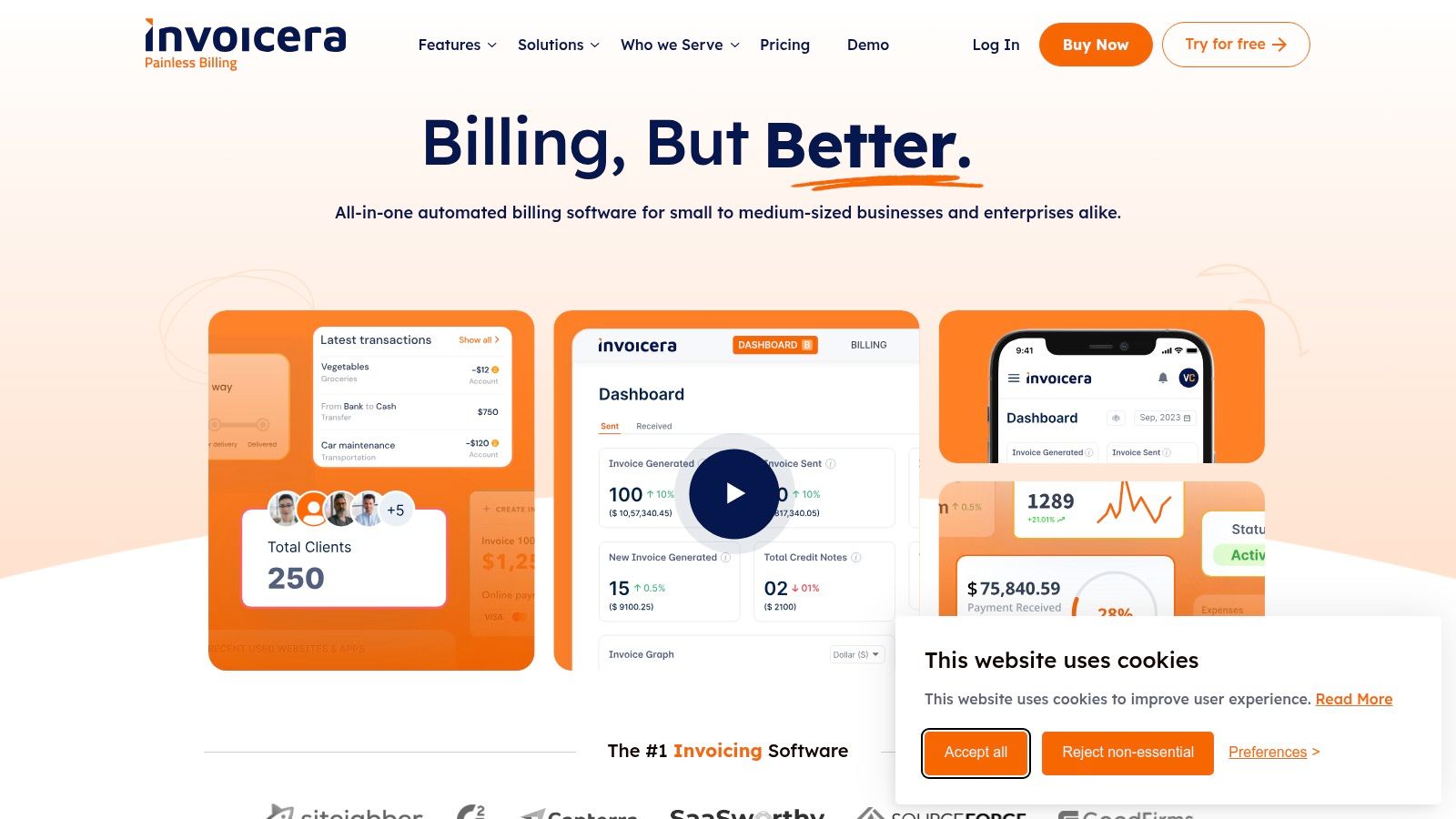
Key Strengths & Use Cases
Invoicera’s main strength lies in its exceptional customization and global reach. With multi-currency and multi-language support, it's ideal for freelancers and businesses with an international client base. The platform’s integration with over 30 payment gateways provides unparalleled flexibility in how you get paid. This robust functionality is perfect for businesses that need to automate complex billing cycles and want detailed financial reports to track revenue, expenses, and tax summaries without manual spreadsheet work.
Limitations
The platform's extensive feature set can come with a steeper learning curve, meaning new users may need extra time for setup and onboarding. While it offers different tiers, the pricing for its more advanced plans can be a significant investment for startups or smaller businesses who may not need the full range of enterprise-level features.
You can explore its full suite of features on the Invoicera website.
7. Bill.com
Bill.com is a comprehensive cloud-based platform designed to automate both accounts payable and receivable. As an end-to-end invoice automation software, it moves beyond simple data capture to streamline the entire financial workflow, from invoice creation and approval to payment processing. It is engineered for businesses of all sizes looking to gain tighter control over their financial operations and improve cash flow management.

Key Strengths & Use Cases
What makes Bill.com a market leader are its highly customizable, multi-step approval workflows. This is ideal for organizations where invoices require sign-off from different departments or managers before payment is issued. It also excels with its international payment capabilities, simplifying transactions with overseas vendors. The platform’s robust integrations with major accounting systems like QuickBooks and Xero ensure data remains synchronized. For businesses evaluating how it measures up, exploring Bill.com alternatives can provide a clearer picture.
Limitations
While its feature set is extensive, the pricing structure might be a hurdle for very small businesses or solopreneurs, as costs can scale with transaction volume and user count. The initial setup can also be more involved than simpler tools, often requiring dedicated time to configure the intricate approval chains and integrations to match specific business processes.
You can see the full scope of its AP and AR automation on the Bill.com website.
8. PayPal Invoicing
For businesses already operating within the PayPal ecosystem, PayPal Invoicing offers a direct and uncomplicated path to billing clients. It is less of a comprehensive platform and more of an integrated feature, designed for freelancers and small businesses that prioritize speed and payment convenience. While not a robust invoice automation software for complex accounts payable, it excels at streamlining the accounts receivable process by combining invoice creation, sending, and payment processing into a single, familiar interface.
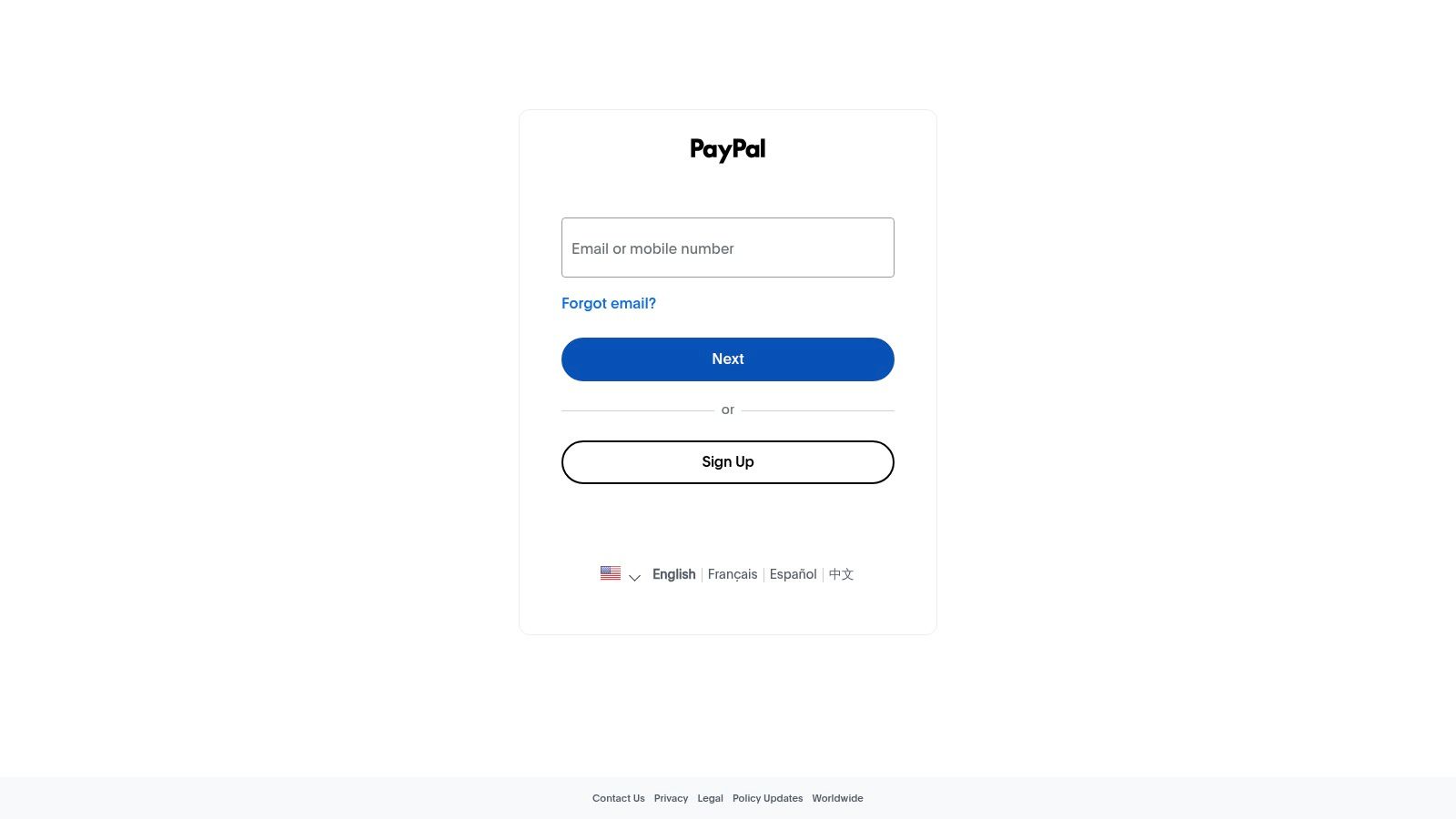
Key Strengths & Use Cases
The primary advantage of PayPal Invoicing is its seamless integration with PayPal's payment gateway. This creates a frictionless experience for clients, who can pay invoices instantly using various methods. This is ideal for consultants, gig workers, and e-commerce sellers who need to bill international clients, thanks to its strong multi-currency support. The mobile app allows for on-the-go invoicing, while features like payment tracking and automated reminders handle basic follow-up without requiring complex setup or a monthly subscription fee.
Limitations
PayPal's simplicity is also its main constraint. Customization options for templates are minimal, and it lacks the advanced automation features found in dedicated software, such as approval workflows or AI-powered data extraction. The tool is built for sending invoices, not for managing incoming bills. Furthermore, while there are no monthly fees, businesses pay standard PayPal transaction fees on every payment received, which can be more costly than a flat subscription for businesses with high transaction volumes.
You can start creating invoices directly from your account at PayPal Invoicing.
9. Square Invoices
Square Invoices is a core component of the Square business ecosystem, offering a streamlined path to billing and payments. It enables small businesses and freelancers to easily create, send, and manage invoices from a single dashboard or mobile app. While not a dedicated AP tool, its value as an invoice automation software is rooted in its seamless integration with Square’s payment processing, making it incredibly simple to get paid.

Key Strengths & Use Cases
The platform is a natural fit for businesses already using Square for point-of-sale or online payments, such as cafes, contractors, and consultants. Key strengths include setting up recurring invoices for retainers and sending automated payment reminders. When comparing payment processors, it is useful to know that platforms like Stripe offer multiple automatic payment attempts, providing a different approach to collections than simple reminders.
Limitations
Square's primary focus is on payments, so its invoicing features lack the advanced workflow automation and approval routing found in specialized platforms. It is built for simplicity, not complex accounts payable processes. While attractive for low-volume users, the pay-per-transaction pricing model can become more costly than a flat subscription for businesses processing a high number of invoices.
You can learn more about its capabilities on the Square Invoices website.
10. Wave
Wave carves out a unique space by offering a completely free invoicing and accounting platform designed for freelancers and small businesses. While many tools focus on one piece of the puzzle, Wave provides a comprehensive financial toolkit. This makes it a powerful entry-point invoice automation software for entrepreneurs who need to send unlimited, professional invoices and manage their core bookkeeping without a monthly subscription fee. It allows users to create and send invoices, track their status, and accept online payments directly.
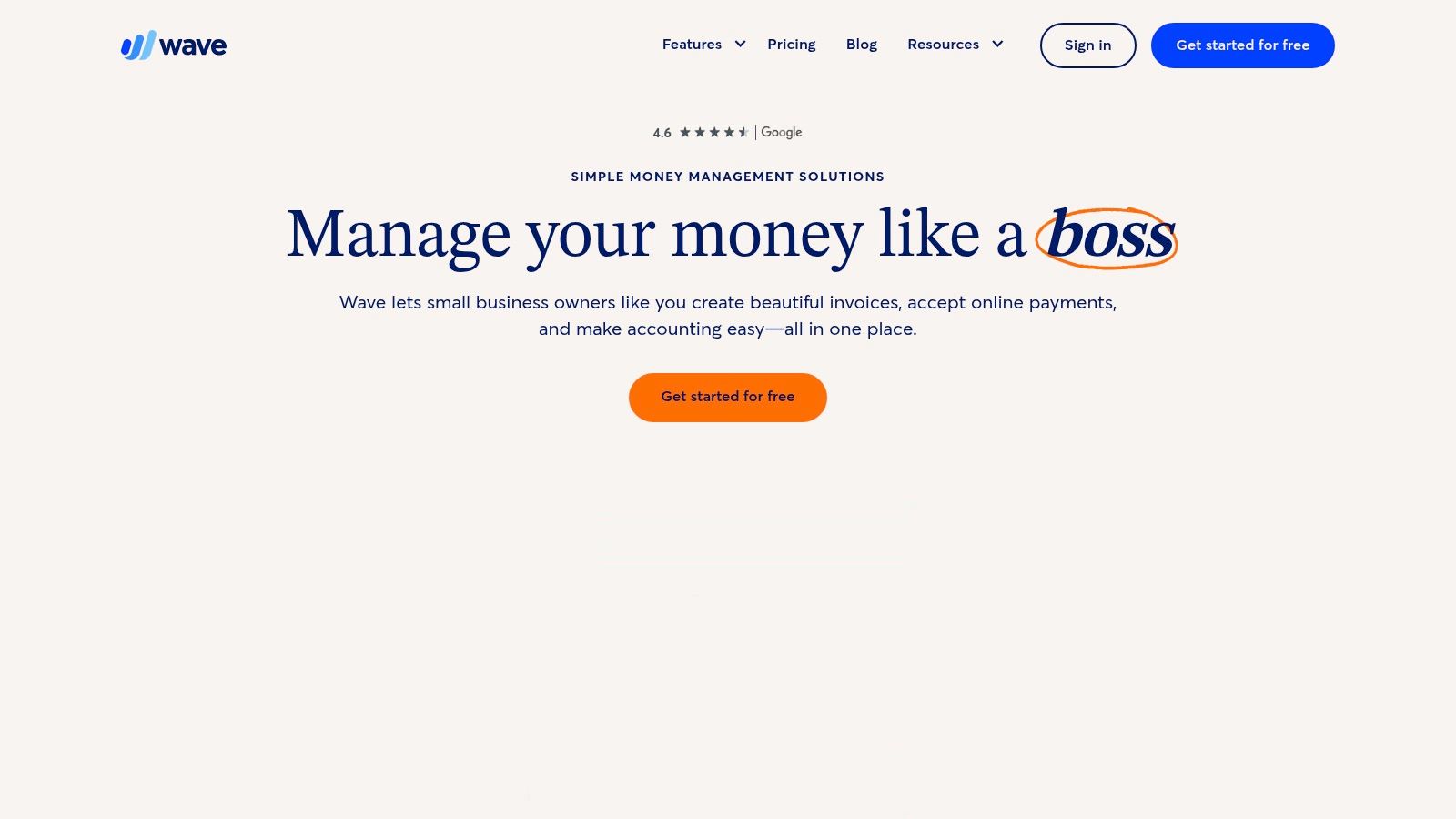
Key Strengths & Use Cases
Wave’s greatest strength is its integrated ecosystem. It's ideal for service-based businesses, consultants, and contractors who need to manage the entire client financial lifecycle in one dashboard. You can create a custom invoice, send it, set up automated payment reminders, and then categorize the income and payment processing fees in the connected accounting ledger. The platform’s receipt scanning feature also helps manage expenses, providing a holistic view of business profitability. This all-in-one approach eliminates the need to juggle separate tools for invoicing and bookkeeping.
Limitations
The trade-off for its free model is a lack of advanced automation and scalability. Wave does not offer the sophisticated approval workflows, deep third-party integrations (beyond payments and payroll), or AP automation found in enterprise-grade software. Customer support is also limited compared to paid services, relying more on self-help resources. It’s a fantastic starting point, but businesses with growing teams or complex operational needs will eventually outgrow its capabilities.
Discover all the features on the official Wave website.
11. Melio
Melio positions itself as a streamlined accounts payable solution, focusing more on the payment execution part of the invoice lifecycle than deep data processing. It's a user-friendly invoice automation software designed for small businesses in the U.S. seeking to digitize their bill pay process without subscription fees. Simply upload an invoice, and its OCR technology extracts key details to quickly set up a payment.
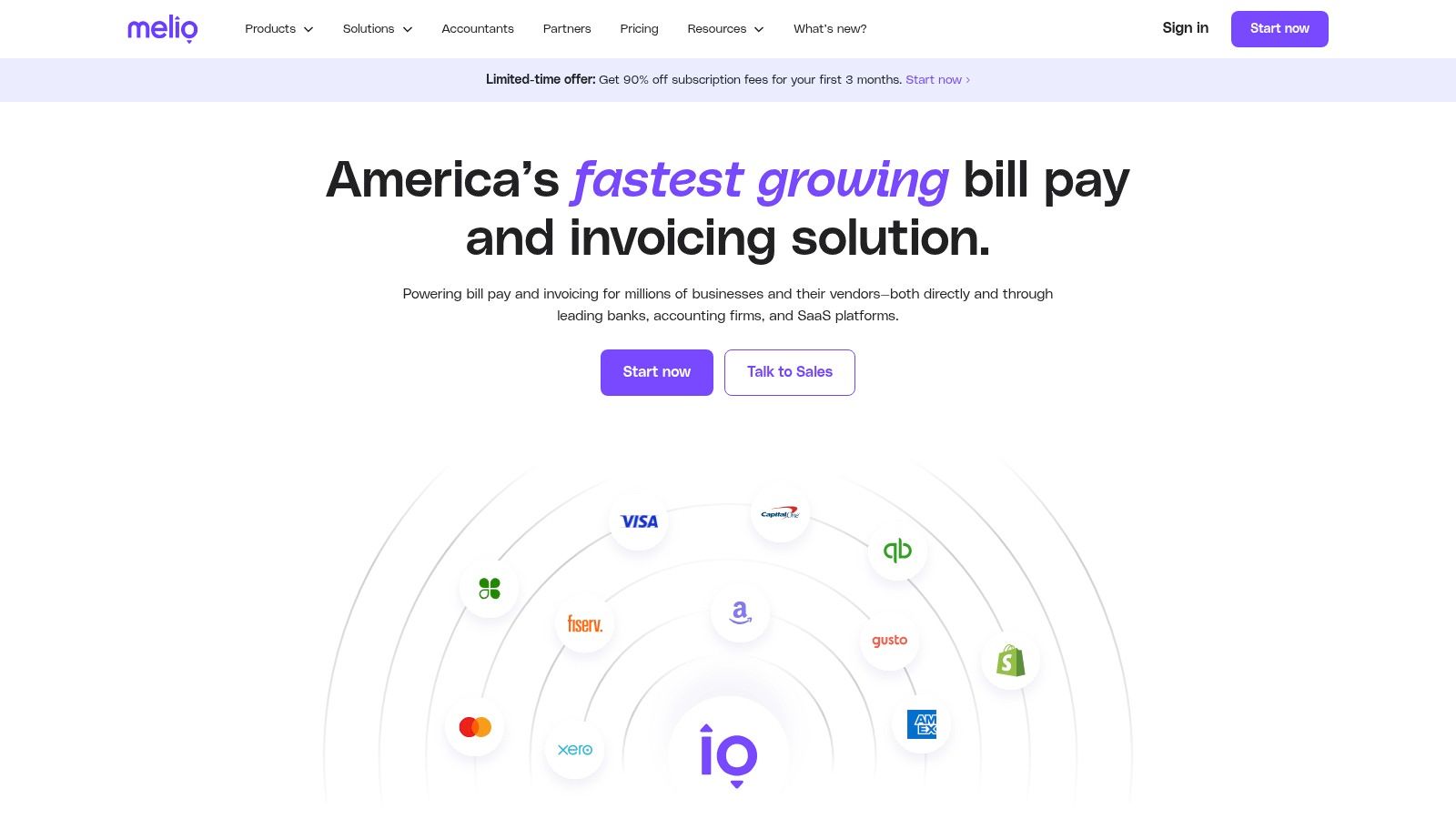
Key Strengths & Use Cases
Melio’s core strength is its payment flexibility. It's perfect for small business owners who want to pay vendors via free bank transfer (ACH), even if the vendor only accepts checks; the platform mails one for you. This model helps optimize cash flow by letting you pay invoices with a credit card (for a fee) while your vendor gets a direct deposit. Its tight integration with QuickBooks Online makes it ideal for accountants managing bill pay for multiple clients.
Limitations
While excellent for payments, Melio lacks advanced workflow automation, multi-level approvals, and the deep analytics found in more comprehensive platforms. Its primary focus is on the final payment step, not granular invoice management. Businesses should also note that while ACH transfers are free, other methods like credit card payments or fast checks incur transaction fees.
You can explore their straightforward payment solutions on the Melio website.
12. Invoice2go
Invoice2go is a mobile-first invoice automation software built specifically for small business owners, freelancers, and tradespeople. Its entire design philosophy centers on simplicity and on-the-go functionality, allowing users to create, send, and track professional invoices directly from their smartphones or tablets. The platform empowers users to manage their billing cycle from anywhere, turning their mobile device into a complete invoicing hub.

Key Strengths & Use Cases
The core strength of Invoice2go lies in its exceptional ease of use and mobile convenience. It is the perfect tool for field service professionals like contractors, consultants, and photographers who need to generate an invoice and accept payment immediately after a job is completed. Features include customizable templates that reflect your brand, simple expense tracking by snapping photos of receipts, and integrated payment processing. This makes it ideal for streamlining the quote-to-cash process for sole proprietors.
Limitations
While excellent for mobile invoicing, Invoice2go is not a comprehensive accounts payable automation tool. It lacks advanced features like automated data capture from vendor bills, multi-level approval workflows, or deep integrations with complex ERP systems. Its focus is squarely on accounts receivable for micro-businesses, making it unsuitable for companies managing a high volume of incoming supplier invoices or requiring sophisticated financial controls.
You can learn more about its mobile-centric features on the Invoice2go website.
Invoice Automation Software Comparison: Top 12 Tools
| Product | Core Features / AI Automation | User Experience & Quality ★ | Value Proposition 💰 | Target Audience 👥 | Unique Selling Points ✨ |
|---|---|---|---|---|---|
| 🏆 GetInvoice | AI-driven data extraction, multi-format capture, custom rules, reconciliation across currencies | ★★★★★ Real-time inbox monitoring, Chrome extension, seamless workflow integration | Free up to 10 invoices/mo; subscription for more | Accountants, finance teams, enterprises, startups | Enterprise-grade security, Tier-2 CASA, GDPR, bot-based paper receipt processing |
| FreshBooks | Recurring invoices, time & expense tracking, multi-currency support | ★★★★ User-friendly, comprehensive mobile app | Mid-tier pricing; suited for freelancers & SMBs | Freelancers, small businesses | Integrated time tracking with invoicing |
| Zoho Invoice | Custom templates, time tracking, client portal | ★★★★ Free plan, easy to learn | Free up to 5 customers; limited users | Small businesses, freelancers | Seamless integration with Zoho suite |
| Xero | Invoice automation, real-time bank feeds, multi-currency | ★★★★ Intuitive, powerful mobile app | Mid to high pricing, scalable | SMBs with international needs | Strong bank reconciliation & currency handling |
| QuickBooks Online | Extensive accounting + invoicing, multi-currency | ★★★★ Strong support, broad integrations | Higher price tiers; comprehensive features | Small to medium businesses | Robust accounting ecosystem integration |
| Invoicera | Customizable invoices, multi-currency & language, financial reporting | ★★★ Customizable, wide payment gateways | Pricing mid to high; flexible for various business sizes | Growing businesses, enterprises | 30+ payment gateway integrations |
| Bill.com | AP/AR automation, approval workflows, major accounting integration | ★★★★ Strong control, reduces manual entry | Pricing on higher side, complex setup | Medium to large businesses | Approval workflows, international payments |
| PayPal Invoicing | Simple invoice creation, multi-currency, payment tracking | ★★★ Easy, no monthly fees | Pay per transaction | Freelancers, very small businesses | No monthly fees, direct PayPal payment integration |
| Square Invoices | Custom templates, recurring invoices, payment reminders | ★★★ User-friendly, no monthly fees | Pay per transaction | Small businesses | Integration with Square POS ecosystem |
| Wave | Unlimited free invoices, automated reminders | ★★★ Free, user-friendly | Fully free | Freelancers, small businesses | All-in-one free invoicing + accounting |
| Melio | OCR invoice data extraction, payment scheduling | ★★★ Easy setup, pay per transaction | No subscription fees | SMBs focused on payables | Payment scheduling with varied payment methods |
| Invoice2go | Customizable invoices, expense tracking, client management | ★★★ Mobile-focused, easy setup | Subscription-based pricing | Micro & small business owners | Mobile-first invoicing with multiple payment options |
Making Your Final Choice: Which Invoice Automation Tool Wins?
Navigating the world of invoice automation software can feel like a journey with a dozen different paths. After exploring everything from comprehensive accounting suites like QuickBooks and Xero to specialized powerhouses like Bill.com and GetInvoice, one thing is clear: there is no single "best" tool. The real winner is the platform that aligns perfectly with your specific workflow, business size, and primary challenges.
The right choice is about identifying your biggest bottleneck. Are you a freelancer who just needs a faster way to create and send professional invoices? Tools like FreshBooks or Wave are brilliant, low-friction starting points. If your business is already thriving within the Zoho or QuickBooks ecosystem, leveraging their native invoicing features is often the most seamless and cost-effective path, ensuring perfect data synchronization.
Recapping Your Options: A Spectrum of Solutions
Think of the market in a few key categories. On one end, you have all-in-one platforms that bundle invoicing with full-scale accounting. On the other, you have highly specialized tools designed to solve one problem exceptionally well.
- •For the Integrated Business: If your operations live inside Xero, QuickBooks Online, or the Zoho suite, their built-in invoicing tools are your most logical choice. They offer deep integration that third-party apps can struggle to match.
- •For the Solopreneur and Small Business: Simplicity is king. Wave, Square Invoices, and PayPal Invoicing excel here, focusing on easy invoice creation and straightforward payment collection without overwhelming you with features you don't need.
- •For High-Volume and AP/AR Focus: When your primary pain is managing a high volume of incoming bills or complex approval workflows, a dedicated solution is non-negotiable. This is where platforms like Bill.com, Melio, and GetInvoice shine, bringing sophisticated automation to the accounts payable and receivable process.
Key Questions to Guide Your Decision
Before you pull out your credit card, take a moment to reflect on what you truly need. Answering these questions will point you directly to the right solution for your business.
- •What is my biggest invoicing headache? Is it manual data entry from PDF invoices, chasing down late payments, or getting approvals from multiple team members?
- •What is my current and projected invoice volume? A tool that’s perfect for 10 invoices a month might crumble under the pressure of 500.
- •What other software must this tool connect with? Your accounting platform is the most obvious, but also consider your CRM, project management, or e-commerce software.
- •Who needs to use this software? Ensure the interface is intuitive for everyone who will touch it, from accountants to project managers.
Your final step should always be a hands-on test drive. Almost every invoice automation software on our list offers a free trial or a free plan. Use it. Upload a few of your most challenging real-world invoices and run them through the system. This practical test is the single best way to know if a tool will truly make your life easier or just create a new set of problems.
If your deep-dive revealed that your biggest challenge is the sheer volume of manual data entry from inbound invoices, then a specialized, AI-driven platform is your most powerful ally. Explore how GetInvoice uses cutting-edge AI to automatically extract data from any invoice, eliminating manual work and freeing your team for more valuable tasks.